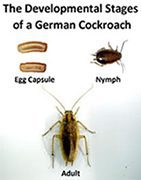Identification and Life Cycle
The German cockroach is one of the more common, and smaller of the cockroach species. They have adapted successfully to living with humans in houses, apartments, restaurants, hotels, and other institutions.
The adult has two dark parallel lines running from the back of its head to the wings and is 1/2 to 5/8- inch long with a flat elongated body that is a light or dark brown. They have six legs, a set of long antennae, and wings (they do not fly). Nymphs (baby/young), are smaller in appearance to the adults, and lack wings.
German cockroaches produce a large number of eggs per capsule and undergo a short time from hatching until sexual maturity. This results in a rapid population growth which can make them difficult to control.
The females produce a light brown, purse-shaped egg capsule that is less than 1/4 -inch long and contains two rows of eggs. Each egg capsule contains approximately 30 to 40 eggs, and females can produce up to 4 to 8 egg capsules during their lifetime. The average lifespan of the adult female can vary from 20 to 30 weeks.
They can be found usually in damp environments such as bathrooms and kitchens (near dishwashers, stoves, refrigerators and sinks). Cockroaches are mostly scavengers and will feed on a wide variety of foods preferably starches, sweets, grease, and meat products.




Comments are closed.